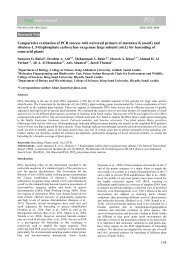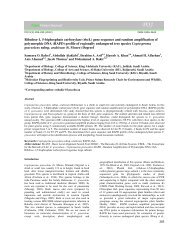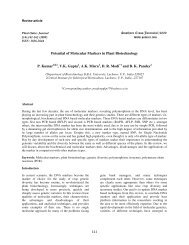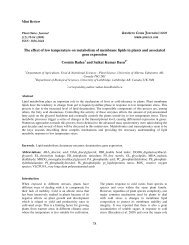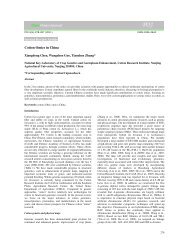Yield and quality management of rose (Rosa hybrida ... - Plant Omics
Yield and quality management of rose (Rosa hybrida ... - Plant Omics
Yield and quality management of rose (Rosa hybrida ... - Plant Omics
You also want an ePaper? Increase the reach of your titles
YUMPU automatically turns print PDFs into web optimized ePapers that Google loves.
Latimer <strong>and</strong> Baden (1994) examined the different GA3 levels<br />
on Pelargonium ‘Ringo <strong>rose</strong>’ <strong>and</strong> ‘Ringo white’ <strong>and</strong> found that<br />
the 150 mg l -1 CCC decreased shoot weight. In current study,<br />
all levels <strong>of</strong> CCC, diminished shoot weight, as well.<br />
Flower stem height is also one <strong>of</strong> the most important<br />
qualitative factors, which was influenced by GA3 <strong>and</strong> CCC. The<br />
least <strong>and</strong> highest flower stem height (length) were obtained by<br />
using 1500 mg l -1 CCC (29.93 cm) <strong>and</strong> 300 mg l -1 GA3 (49.33<br />
cm), respectively. The stem length was 35.7 cm in control<br />
plants (Fig 2). Our results showed a significant increase in stem<br />
length <strong>of</strong> flowers under GA3 treatments <strong>and</strong> extremely decline<br />
under CCC application (Fig 2). Roberts et al. (1999) confirmed<br />
the effect <strong>of</strong> GA3 on increasing <strong>of</strong> internode length. Also,<br />
Saffari et al. (2004) sprayed the <strong>Rosa</strong> damascena plants with 50<br />
mg l -1 GA3 <strong>and</strong> found that this compound could increase flower<br />
stem height (77.5 cm) compared to control (69.2 cm). They<br />
revealed that 3000 mg l -1 CCC decreased flower stem length<br />
about 5 cm relative to control. <strong>Plant</strong> growth retardants<br />
decreased the inter node length <strong>and</strong> eliminated the apical<br />
dominance (Khangoli, 2001; Lee et al., 1999).<br />
Gul et al. (2006) evaluated application <strong>of</strong> 100, 200 <strong>and</strong> 300<br />
mg l -1 GA3 on Araucaria heterophylla <strong>and</strong> observed that<br />
maximum plant height (42.4cm) can be achieved at 300 mg l -1<br />
GA3 while minimum height (26.5 cm) was observed in control<br />
plants.<br />
In our experiment, different levels <strong>of</strong> SA did not show any<br />
significant effect on flower stem length compared to control<br />
plants (Fig 1). The most vase life (12.67 days) was obtained at<br />
150 mg l -1 SA (P≤ 0.01). Other levels <strong>of</strong> SA, GA3 <strong>and</strong> CCC<br />
increased the vase life a little, compared to the control plants<br />
(9.67 days), but none <strong>of</strong> these elevations were significant (Table<br />
1).<br />
Obviously, application <strong>of</strong> SA could reduce the synthesis <strong>of</strong><br />
ethylene <strong>and</strong> make the plant capable to blocks the synthesis <strong>of</strong><br />
auxins (Gour <strong>and</strong> Chenulu, 1982; Shekari et al., 2003). As<br />
mentioned above, application <strong>of</strong> SA has increased the dry<br />
matter <strong>and</strong> consequently vase life <strong>of</strong> flowers (Chan et al., 2008).<br />
Also SA acts as an internal signal <strong>and</strong> causes a kind <strong>of</strong> systemic<br />
resistance in mature organs, so this resistance will be<br />
transported to the immature organs later (Simons, 1991).<br />
Salicylic acid also participates in signal regulation <strong>of</strong> gene<br />
expression in the course <strong>of</strong> leaf <strong>and</strong> petal senescence (Hussein<br />
et al., 2007).<br />
GA3, CCC <strong>and</strong> SA had significant effect on the number <strong>of</strong><br />
cut flowers per unit area (P≤ 0.05). The highest yield was<br />
obtained at 200 <strong>and</strong> 250 mg l -1 <strong>of</strong> GA3 concentrations with 192<br />
<strong>and</strong> 186 cut flowers m -2 y -1 , respectively (56.8 <strong>and</strong> 50%<br />
increasing <strong>of</strong> yield compared to control). The concentration <strong>of</strong><br />
300 mg l -1 <strong>of</strong> GA3 decreased the yield (Figure 3).<br />
Barzegar Fallah (2006) applied 0, 10, 25 <strong>and</strong> 50 mg l -1 GA3 on Aquilegia × <strong>hybrida</strong> <strong>and</strong> observed that the highest yield was<br />
obtained in 10 mg l -1 GA3, while 50 mg l -1 GA3 caused<br />
diminishing <strong>of</strong> cut flowers. Also, Bhattacharjee <strong>and</strong> Singh<br />
(Bhattacharjee <strong>and</strong> Singh, 1995) showed that 300 mg l -1 GA3 decreased yield <strong>of</strong> <strong>rose</strong> ‘Raktag<strong>and</strong>ha’ up to 11-20%. In current<br />
study, 300 mg l -1 GA3 reduced yield <strong>of</strong> cut <strong>rose</strong> ‘Poison’.<br />
In conclusion, the highest yield, flower stalk height <strong>and</strong><br />
fresh weight were achieved by using GA3. The lowest flower<br />
stalk height, also the most bud length <strong>and</strong> the highest vase life<br />
were obtained by CCC <strong>and</strong> SA treatments, respectively.<br />
Acknowledgements<br />
This work was supported by a grant from the Islamic Azad<br />
University, Rasht Branch, Rasht, Iran. Authors would like to<br />
thank the university.<br />
References<br />
Abdi G, Hedayat M, Askari N (2009) Effect <strong>of</strong> different<br />
concentrations <strong>of</strong> salicylic acid on growth <strong>and</strong> flowering<br />
<strong>of</strong> marigold (Tagetes erecta). Proc 6 th Iranian Hort Sci<br />
Cong. 12-15 July, Rasht, Iran, Page: 345.<br />
Arun DS, Ashok AD, Rengasamy P (2000) Effect <strong>of</strong> some<br />
growth regulating chemicals on growth <strong>and</strong> flowering <strong>of</strong><br />
<strong>rose</strong> ’First red’ under greenhouse conditions. J Ornament<br />
Hort New Series. 3 (1): 51-53.<br />
Barzegarfallah P (2006) Effect <strong>of</strong> temperature <strong>and</strong> different<br />
concentrations <strong>of</strong> GA on growth <strong>and</strong> flowering <strong>of</strong><br />
Aquilegia×<strong>hybrida</strong>. MS thesis, Islamic Azad Univ,<br />
Science <strong>and</strong> Research Compus. Tehran, Iran.<br />
Bhattacharjee SK, Singh UC (1995) Growth <strong>and</strong> flowering<br />
response <strong>of</strong> <strong>Rosa</strong> <strong>hybrida</strong> ‘Raktag<strong>and</strong>ha’ to certain<br />
growth regulator sprays. Orissa J Hort. 83: 275-281.<br />
Chan Z, Wang Q, Xu X, Meng X, Qin G, Li B, Tian S (2008)<br />
Function <strong>of</strong> defense-related proteins <strong>and</strong><br />
dehydrogenases in resistance response induced by SA in<br />
sweetcherry fruits at different maturity stages.<br />
Proteomics. 8: 4791-4807.<br />
Fathipour B, Esmaellpour B (2000) <strong>Plant</strong> growth substances<br />
(principles <strong>and</strong> application), Mashhad Univ Publication.<br />
Gaur A, Chenulu VV (1982) Chemical control <strong>of</strong> postharvest<br />
disease <strong>of</strong> Citrus reticulata <strong>and</strong> Solanum tuberosum.<br />
Indian Phytopath. 35: 623-632.<br />
Gul H, Khattak AM, Amin N (2006) Accelerating the growth <strong>of</strong><br />
Araucaria heterophylla seedling through different GA3<br />
concentrations <strong>and</strong> nitrogen levels. J Agric Biological Sci.<br />
1 (2):<br />
Hedayat M (2001) Application <strong>of</strong> plant growth retardants in<br />
greenhouse. Proc First Applied Sci Seminar on Flowering<br />
<strong>and</strong> Ornamental <strong>Plant</strong>s. Mahallat, Iran. pp. 55-56.<br />
Hisamatsu T, Koshioka M, Kubota S, Nishijima T, Yamane H,<br />
King RW, M<strong>and</strong>er LN (1998) Isolation <strong>and</strong> identification<br />
<strong>of</strong> GA112 in Matthiola incana. Phytochem. 47: 3-6.<br />
Hussein MM, Balbao LK, Gaballah MS (2007) Salicylic acid<br />
<strong>and</strong> salinity effects on growth <strong>of</strong> maize plants. Research<br />
J Agric Biol Sci. 3 (4): 321-328.<br />
Khalighi A (2001) Floriculture. Ruzbahan Publisher. Tehran,<br />
Iran. pp. 450.<br />
Khangoli S (2001) Potential <strong>of</strong> growth regulators on control <strong>of</strong><br />
size <strong>and</strong> flowering <strong>of</strong> ornamental plants. Proc First<br />
Applied Sci Seminar on Flowering <strong>and</strong> Ornamental<br />
<strong>Plant</strong>s. Mahallat, Iran<br />
Kumar R, Singh K (2003) Effect <strong>of</strong> growth regulator <strong>and</strong> shoot<br />
tip pinching on carnation. J Ornamental Hort New Series.<br />
6 (2): 134-136.<br />
Latimer JG, Beden SA (1994) Persistent effect <strong>of</strong> plant growth<br />
regulators on l<strong>and</strong>scape performance <strong>of</strong> seed geraniums. J<br />
Environ Hort. 12 (3): 150-154.<br />
Lee JH, Jin ES, Kim WT (1999) Inhibition <strong>of</strong> auxin-induced<br />
ethylene production by SA in mungbean hypocotyls. J<br />
<strong>Plant</strong> Biol. 42: 1-7.<br />
170



